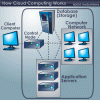What exactly is "the cloud"?
You are using an out of date browser. It may not display this or other websites correctly.
You should upgrade or use an alternative browser.
You should upgrade or use an alternative browser.
Technology Inquiry
- Thread starter August West
- Start date
What exactly is "the cloud"?
Technically it's just storage space that is not in your own physical location.
It's a bunch of servers that you can store data on. That's all it really is. I guess they call it "the cloud", because you send your data up to it, I.e. upload it.
I thought it is where naked celebrity pictures are kept.
Ceci n'est pas un nuage.
C'est quoi alors?
Don't worry, all of the servers for the cloud are stored in the Ukraine and Northern Iraq where they are fairly safe.
- Thread starter
- #10
So all the servers are in France?
So all the servers are in France?
Je ne sais pas, mais si Tony le dit ça doit être vrai.
- Thread starter
- #12
Je ne sais pas, mais si Tony le dit ça doit être vrai.
Rire á haute voix!
RAHX! for short.
a
I thought it is where female celebrity pictures are kept.
*fixed
and:

Wikipedia explains it quite nicely:
Cloud computing is internet-based computing in which large groups of remote servers are networked to allow sharing of data-processing tasks, centralized data storage, and online access to computer services or resources.
The origin of the term cloud computing is unclear. The expression cloud is commonly used in science to describe a large agglomeration of objects that visually appear from a distance as a cloud and describes any set of things whose details are not inspected further in a given context.
In analogy to above usage the word cloud was used as a metaphor for the Internet and a standardized cloud-like shape was used to denote a network on telephony schematics and later to depict the Internet in computer network diagrams. With this simplification, the implication is that the specifics of how the end points of a network are connected are not relevant for the purposes of understanding the diagram. The cloud symbol was used to represent the Internet as early as 1994,[SUP][10][/SUP][SUP][11][/SUP] in which servers were then shown connected to, but external to, the cloud.
References to cloud computing in its modern sense can be found as early as 1996, with the earliest known mention to be found in a Compaq internal document.[SUP][12][/SUP]
The popularization of the term can be traced to 2006 when Amazon.com introduced the Elastic Compute Cloud.[SUP][13]
[/SUP]
Cloud computing is internet-based computing in which large groups of remote servers are networked to allow sharing of data-processing tasks, centralized data storage, and online access to computer services or resources.
The origin of the term cloud computing is unclear. The expression cloud is commonly used in science to describe a large agglomeration of objects that visually appear from a distance as a cloud and describes any set of things whose details are not inspected further in a given context.
In analogy to above usage the word cloud was used as a metaphor for the Internet and a standardized cloud-like shape was used to denote a network on telephony schematics and later to depict the Internet in computer network diagrams. With this simplification, the implication is that the specifics of how the end points of a network are connected are not relevant for the purposes of understanding the diagram. The cloud symbol was used to represent the Internet as early as 1994,[SUP][10][/SUP][SUP][11][/SUP] in which servers were then shown connected to, but external to, the cloud.
References to cloud computing in its modern sense can be found as early as 1996, with the earliest known mention to be found in a Compaq internal document.[SUP][12][/SUP]
The popularization of the term can be traced to 2006 when Amazon.com introduced the Elastic Compute Cloud.[SUP][13]
[/SUP]
Wikipedia explains it quite nicely:
Cloud computing is internet-based computing in which large groups of remote servers are networked to allow sharing of data-processing tasks, centralized data storage, and online access to computer services or resources.
The origin of the term cloud computing is unclear. The expression cloud is commonly used in science to describe a large agglomeration of objects that visually appear from a distance as a cloud and describes any set of things whose details are not inspected further in a given context.
In analogy to above usage the word cloud was used as a metaphor for the Internet and a standardized cloud-like shape was used to denote a network on telephony schematics and later to depict the Internet in computer network diagrams. With this simplification, the implication is that the specifics of how the end points of a network are connected are not relevant for the purposes of understanding the diagram. The cloud symbol was used to represent the Internet as early as 1994,[SUP][10][/SUP][SUP][11][/SUP] in which servers were then shown connected to, but external to, the cloud.
References to cloud computing in its modern sense can be found as early as 1996, with the earliest known mention to be found in a Compaq internal document.[SUP][12][/SUP]
The popularization of the term can be traced to 2006 when Amazon.com introduced the Elastic Compute Cloud.[SUP][13]
[/SUP]
+1, it's more than just data storage, although that is a common usage (Google Drive, etc). It's about providing computing resources in the form of of raw machines (sometimes called PAAS - Platform as a Service) all the way up to providing complete solutions or applications over the network (and most of the time - off premises) - usually called SAAS (Software as a Service).
In many respects, it's a return the service based computing model of the mainframe era, although that's just a conceptual similarity. Mechanically it's a lot different, of course.
- Thread starter
- #17
Thanks for clearing that up James.
my head hurts.
C'est la vie
LOL! That's good!
Don't worry, all of the servers for the cloud are stored in the Ukraine and Northern Iraq where they are fairly safe.
Tony,
A big component of the attractiveness of the "Cloud" these days is a combination of elasticity of available resources and the pay per use billing model that Amazon has pioneered to a degree well beyond any previous attempts. Specifically, businesses can put their applications on Amazon's infrastructure and use only what they need. If they have a sudden need for 2x the compute resources or storage, then they can deploy those resources almost automatically with AWS (Amazon Web Services). This allows them to not have to overbuild their own data center for merely temporary bursts in compute or storage requirements. They get flexibility and the option to buy only what they use. They've been able to automate highly granular billing systems so that you pay for exactly the amount of CPU and storage you use. Down to the minute if I recall accurately the seminar I just attended by AWS.
There's a lot more to this and before you walk away thinking it sounds too good to be true, there are some gotchas. Security in the public cloud is not completely worked out, imho, and you're relying on another organization to have the infrastructure you need always available. In the past, this hasn't been the case, but it's by and large not as big a problem today. Of course, AWS is still not making money at this and the day will come where they will have to. Right now, it's economical for many but not all businesses. Prices are still being driven down at a speed similar to what we saw with bandwidth in the 90's and 2000's, but a floor will have to be hit at some point.
As a user, it really shouldn't matter to you; as a business, every company with meaningful IT infrastructure has to look at what it means for their bottom line and strategic IT planning.
'nuff said.
A big component of the attractiveness of the "Cloud" these days is a combination of elasticity of available resources and the pay per use billing model that Amazon has pioneered to a degree well beyond any previous attempts. Specifically, businesses can put their applications on Amazon's infrastructure and use only what they need. If they have a sudden need for 2x the compute resources or storage, then they can deploy those resources almost automatically with AWS (Amazon Web Services). This allows them to not have to overbuild their own data center for merely temporary bursts in compute or storage requirements. They get flexibility and the option to buy only what they use. They've been able to automate highly granular billing systems so that you pay for exactly the amount of CPU and storage you use. Down to the minute if I recall accurately the seminar I just attended by AWS.
There's a lot more to this and before you walk away thinking it sounds too good to be true, there are some gotchas. Security in the public cloud is not completely worked out, imho, and you're relying on another organization to have the infrastructure you need always available. In the past, this hasn't been the case, but it's by and large not as big a problem today. Of course, AWS is still not making money at this and the day will come where they will have to. Right now, it's economical for many but not all businesses. Prices are still being driven down at a speed similar to what we saw with bandwidth in the 90's and 2000's, but a floor will have to be hit at some point.
As a user, it really shouldn't matter to you; as a business, every company with meaningful IT infrastructure has to look at what it means for their bottom line and strategic IT planning.
'nuff said.






